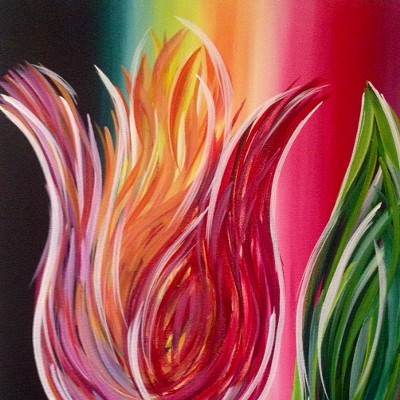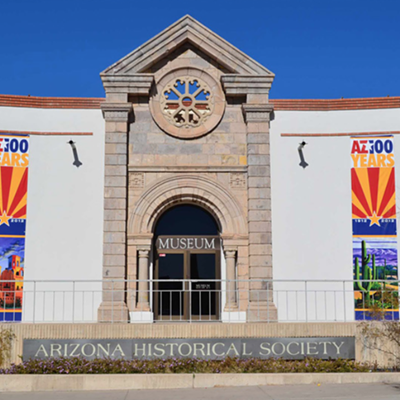His teeming work, 24 feet long by 12 feet high, is a map of the entire world, and crowded into the seething borders of its painted nations are depictions of every murderous injustice imaginable. Skulls are piled up in Southeast Asia, site of Cambodia's killing fields. Haitian boat people are tumbling to their deaths by drowning in the Caribbean Sea. Desaparecidos--citizens "disappeared" by their own governments--take on ghostly life in South America. Klansmen proudly parade in full regalia in the United States, accompanied by cans of Coke, an icon of international capitalism.
Presiding over the disorder of this New World Order, a favorite Republican phrase of a decade ago, is a phalanx of smiling world leaders, from President Reagan to Queen Elizabeth to Castro to assorted genocidal dictators from around the globe. The painting, one of 18 in the retrospective show Alfred Quiroz: Razor's Edge: War, Ideology, Ecstasy, is classic Quiroz. Encyclopedically researched and painted in characteristic caricature, with leering cartoonish figures pushed to the edge of nightmare, the work howls against political evil. One can imagine Quiroz's days of rage in the studio, tempered only by the humor of his cartoon concoctions and his gift for wordplay, so often manifested in his titles. Quiroz does not have an easy job, acting as painterly conscience of the world's infamy, but somebody has to do it.
Quiroz meticulously researches history for its forgotten outrages, its glossed-over massacres and land seizures, and brings them to artistic light courtesy of crayon-bright colors. As curator Paul Eli Ivey notes, Quiroz's stint in Vietnam in 1964 and 1965 "led him to an understanding of the striking difference between propaganda and lived experience." Demolishing patriotic myths has been the artist's job description ever since.
He even paints historical texts onto his canvases, unearthing the callous words of the U.S. Land Act of 1851, say, in his 1996 "Muneefist Destiny," a sprawling denunciation of America's thefts and slaughters during the expansionist days in the Old West. Powerful as his painted history lessons are, sometimes they're not enough. We want to know more, for instance, about the 1847 Battle of Los Angeles depicted in "Muneefist Destiny," or the depredations of its presidents Polk the Mendacious and James Buchanan, champion of Anglo-Saxon superiority. A viewer longs for a scorecard, if not historical notes, and, in such crowded paintings as "Novus Ordo," a key to the villains. We want the name of each and every ogre.
He's an art rebel as well, who nimbly jumps genre boundaries. Abandoning standard geometries, he often cuts out his wood or canvas paintings, jackhammering them into the shape of nations or giant presidential heads. Sometimes he turns the works into 3-D sculptures, by pulling a figure away from the main canvas or setting up a painted coffin on the floor, as in 1990's "Alla en el Rancho Grande," his lament for a Chicano soldier killed in the Korean War.
Ivey, Quiroz's colleague in the UA art department, begins the show with Quirozes from the late '60s. From the start, the artist was a rebel, attacking not just political sins but religious hypocrisies. The earliest piece, a 1968 oil on canvas, "The Lord Has Come," takes on the Virgin Birth, the Christian doctrine embodying disdain of human (and especially female) sexuality. A naked God the Father, having disported himself most carnally, arises from the bed of a bare-breasted Virgin Mary with a look of sheer joy on his face. As Ivey notes in an essay, Quiroz has often illuminated the close relationship between the erotic and the ecstatic.
Quiroz is at his most satirical in his presidential series. He has great fun with the movie-star prez, surrounding "Da Grate Kommie-nuke-ater" (President Reagan, the Great Communicator) both with black-and-white painted images from his gun-slinging movies and the bomb bursts of his Star Wars weaponry program. (At least the terminating California governor-elect can't put his finger on the button.) Bill Clinton comes in for a ribbing in 1996's "The Pot Party," while the 2003 painting "Bush-whacked" is a somber meditation on the many ways Bush has pushed the country to the right since the attacks of Sept. 11. Bush has used the mass deaths to justify everything from tax cuts for his rich confreres to greater police powers for the state; Quiroz paints his leering face in a wooden TV-like box, decorated with patriotic stars and stripes, in a deathlike monochrome of grays and blacks.
One surprise in Quiroz's rogues' gallery is an affectionate 1978 portrait of his grandfather, painted on horseback in a near-realist style suggestive of photography. The man is dressed in full Mexican cowboy regalia and poses proudly on a dusty street in a town that could well be Tucson. Quiroz's Mexican-American heritage has always played a crucial role in his art. He frequently returns to the ambiguities of the Virgin of Guadalupe, a cultural symbol who holds everything from Catholicism to indigenous religion to ethnic identity within the embrace of her flames.
She appears as a heavenly reward--transformed into a blue-eyed blonde--for the slain Latino soldier in "Alla en El Rancho Grande," the searing multimedia piece about a death in the Korean War. This work, seen before in the UA faculty show at the University of Arizona Museum of Art, is the most powerful in the exhibition. It's a triptych, with the left-hand painting showing a proud mama in her kitchen dreaming of success for her singing son, who strums a guitar at the kitchen table. The central panel shows his apotheosis; his decapitated body lies on the jungle floor, while his spirit ascends to the Guadalupeña paradise. At right, the government, in the form of a cold-faced officer, dispenses a folded flag to the weeping parents at a cemetery, between the crosses row on row.
The coffin, standing on the gallery floor, holds all that's left of the once-and-future Mambo King. A real dog tag and a lighter scratched "Korea 1951" displayed in a glass case suggest a real-life origin for this narrative. The work reminds me of the old anti-Vietnam War song that advised, "Be the first one on your block / to have your boy come home in a box." It's heartbreaking that the 1990 piece, depicting a 1952 war death, is so resonant again in 2003, when young American men, not to mention Iraqis, die daily in a distant desert, "Bushwhacked" by still another American president.














